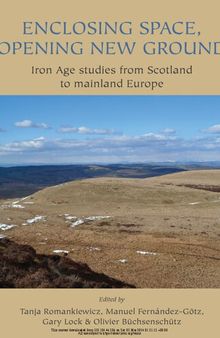 جزییات کتاب
جزییات کتاب
Enclosures are among the most widely distributed features of the European Iron Age. From fortifications to field systems, they demarcate territories and settlements, sanctuaries and central places, burials and ancestral grounds. This dividing of the physical and the mental landscape between an ‘inside’ and an ‘outside’ is investigated anew in a series of essays by some of the leading scholars on the topic. The contributions cover new ground, from Scotland to Spain, between France and the Eurasian steppe, on how concepts and communities were created as well as exploring specific aspects and broader notions of how humans marked, bounded and guarded landscapes in order to connect across space and time. A recurring theme considers how Iron Age enclosures created, curated, formed or deconstructed memory and identity, and how by enclosing space, these communities opened links to an earlier past in order to understand or express their Iron Age presence. In this way, the contributions examine perspectives that are of wider relevance for related themes in different periods.Table of ContentsBibliography of Professor Ian B. M. RalstonTanja Romankiewicz, Manuel Fernández-Götz, Gary Lock & Olivier BüchsenschützEnclosing space and opening new ground in Iron Age studies: An introductionTanja Romankiewicz, Manuel Fernández-Götz, Gary Lock & Olivier BüchsenschützBLOCK 1: BUILDING ENCLOSURES1. Does fortified always equate to defensive? Some thoughts on the fortification systems of the Glauberg hillfortAxel G. Posluschny2. De Architectura Celtica: déclinaisons insolites de Murus GallicusPhilippe Barral & Stephan Fichtl, avec Vincent Guichard, Jean-Paul Guillaumet, Martine Joly, Pierre Nouvel & Matthieu Thivet3. Julius Caesar’s assault ramp at the Oppidum of Avaricum in 52 BCSophie Krausz4. How many hillforts are there in Scotland? RevisitedStratford HallidayBLOCK 2: CREATING SETTLEMENT COMMUNITIES5. The hillfort on Mount Ipf: A centre of power during the Bronze and Iron Ages in southern GermanyRüdiger Krause6. Oram’s Arbour, Winchester: A new interpretationJohn Collis7. A new look at the Late Prehistoric settlement patterns of the Forth ValleyMurray Cook, Therese McCormick, Jennifer McAlpine, Ross Greenshields, Gordon Cook & Andrew McLean8. Enclosure, autonomy and anarchy in Iron Age ScotlandIan Armit9. Exploring settlement dynamics through radiocarbon datingW. Derek Hamilton & Colin Haselgrove10. Oppida in Britain in the face of the Roman conquestDavid J. BreezeBLOCK 3: MARKING LANDSCAPES THROUGH TIME11. Atlantic-zone hillforts with up-right stone rows and their relationship with coastal routesLuis Berrocal-Rangel, Pablo Paniego & Lucía Ruano12. Making mounds: monuments in Eurasian prehistoryChris Gosden, Peter Hommel & Courtney Nimura13. Urbanism and identity in Celtic Iberia. What did it mean to be a Vetton, Vaccaean or Carpetanian in Late Iron Age oppida?Jesús R. Álvarez-Sanchís & Gonzalo Ruiz Zapatero14. L’enclos comme expression du pouvoir des aristocrates sur la campagne 169Olivier Büchsenschütz15. Memoryscapes in Late Iron Age Northern Gaul: Warfare and sacrifice from Ribemont to Titelberg 175David Rose & Manuel Fernández-Götz



 دانلود کتاب
دانلود کتاب

 جزییات کتاب
جزییات کتاب





 این کتاب رو مطالعه کردید؟ نظر شما چیست؟
این کتاب رو مطالعه کردید؟ نظر شما چیست؟
